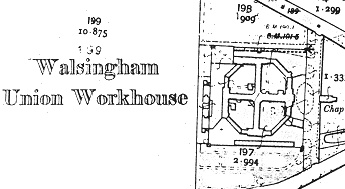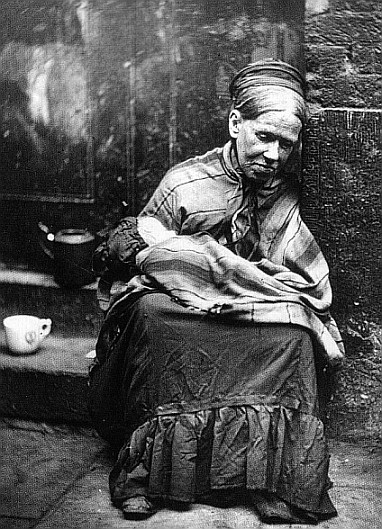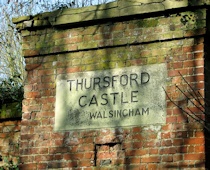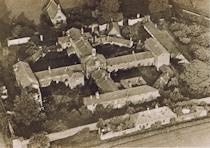The Walsingham Union workhouse was erected in 1836 at Great Snoring.
The new building was originally planned to be situated near Thursford Hall but the landowner (Sir Charles Chad) complained about the workhouse being "greatly prejudicial" to his interest.
After some negotiations it was eventually decided that the complex should be built near Great Snoring, on a plot of land offered by Sir Charles as an alternative. The Poor Law Commissioners authorised an expenditure of £5,900 on construction of the building which was intended to accommodate up to 250 inmates.
The complex soon became known as the "Thursford Castle" and a stone at the south entrance bearing this name is still in place.
It was designed by William Thorold who was also the architect of workhouses for the Depwade, Thetford, and Guiltcross Unions. His design for Walsingham was based on Sampson Kempthorne's model cruciform plan published by the Poor Law Commissioners in 1835. However, the outer buildings at Walsingham gave the workhouse an octagonal rather than the more usual square perimeter.
It comprised an entrance range at the east (consisting of a porter's lodge, board room and offices), four accommodation wings for the various classes of inmate and workshop buildings around the perimeter. The areas between the wings were divided into segregated exercise yards. A chapel stood to the east of the main building. To the rear, radiating from the central supervisory hub, were four accommodation wings for the various classes of inmate (male/female, old/able-bodied etc.). Service and workshop buildings formed the octagonal perimeter of the workhouse. A chapel was situated to the east of the main building. The site location and layout are shown on the 1906 map below.

Description from White's Directory of Norfolk, 1845.
WALSINGHAM UNION comprises all the 16 parishes in North Greenhoe Hundred; 24 parishes in Gallow Hundred, and 10 parishes in Holt Hundred. These 50 parishes extend over an area of 121 square miles, or 72,493 acres; and had in 1841, 20,960 inhabitants, of whom 10,121 were males, and 10,839 females. Their average annual expenditure from 1832 to 1835, was £21,497; but since the formation of the Union, it has been reduced to about half that sum.
The UNION WORKHOUSE is at Great Snoring, and was finished in 1838, at the cost of £5,903. It has room for 300 inmates; but had only 81 in July 1841, and 169 in January, 1845. Mr. John Overton, of Fakenham, is Union Clerk and Supt. Registrar; and Mr. Robt. Platten is master of the Workhouse. The relieving officers are - Mr. Henry Scales, of Fakenham; and Mr. Thos. Webb, of Wells. The Rev. R. Leeder is chaplain. Seven surgeons are employed by the Union, and among them the three following are Registrars of Births and Deaths, viz:- Mr. G. Damant, for Fakenham District; Mr. C. Adcock, for Walsingham District; and Mr. J. Young, for Wells District.
Minutes of the Meetings
By clicking THIS LINK you can view various selected pages from the huge handwritten notebook (over a thousand pages) of the board meetings of the Walsingham Union both before and after the creation of "Thursford Castle". The dates are from May 1836 to April 1838 and give a fascinating glimpse into the inner workings of the workhouse. The pages have been selected to show an overview of:
- the way contributions to the poor were considered
- discussions relating to the purchase of land for the workhouse
- the tenders for building work
- accounts showing what items were being purchased, such as clothing and food
- appointments of new staff
- names of inmates from Little and Great Snoring, showing their disability and circumstances
Births and Deaths at the Workhouse
On this page you can see the BOOK recording births and deaths at the Walsingham Union. (Because of size constraints and the default compression of this book, the details are sometimes unclear.)
- On this page you can see a transcript of the WORKHOUSE BIRTHS
- On this page you can see a transcript of the WORKHOUSE DEATHS
- (Many thanks to Jessica for the above)
 ALSO SEE: Inmates of the Workhouse from 1841-1911 from the Great Snoring census
ALSO SEE: Inmates of the Workhouse from 1841-1911 from the Great Snoring census
Closure
After closure of the workhouse in the 1930s the buildings housed a smallpox hospital and in the 1950s they were used by the Civil Defence. In 1961 planning approval was obtained for conversion into 35 flats. This, however, never materialised and the buildings have since been demolished.
The derelict workhouse chapel is the largest structure that remains. A stone at the south-east entrance to the site bears the name "Thursford Castle" by which the institution became known.
HOW TO FIND IT: The Workhouse was at Great Snoring and located at a junction (west of Thursford Common and north of Vinepark Farm) on the Thursford to Little Walsingham Road where the side road goes to Great Snoring, c. NR21 0PB, [Map reference is TF967352]
Slideshow
I make no claim to ownership of these photos, nor make any copyright on them. They are for display and educational purposes only. Thursford Castle photos (c) Evelyn Simak.










